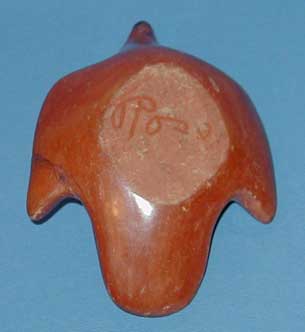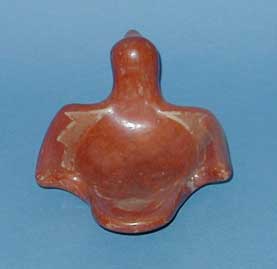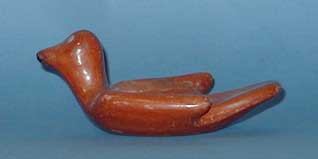 ClayHound Web
- San Ildefonso
Pottery
ClayHound Web
- San Ildefonso
PotteryReturn to:
 |
|
||||||||||||||
|
|
|
||||||||||||||
|
|
|
||||||||||||||
 |
 |
||||||||||||||
|
Nationality: San Juan
Pueblo PERSONALBorn: Rose Cata, San Juan Pueblo, New Mexico, c. 1900. Family: Married Robert Gonzales, 1920, and moved to his native San Ildefonso Pueblo. Education: Santa Fe Indian School; learned pottery from her mother-in-law, Ramona Sanchez Gonzales. Career: Potter since the 1920s; demonstrated and taught pottery making at San Ildefonso. Died: 1989. WRITINGS:SELECTED GROUP EXHIBITIONS
COLLECTIONS
NARRATIVE ESSAY:Rose Gonzales is among the great twentieth-century potterymakers of the Pueblos, contributing to the revitalization of the art, introducing innovations, and beginning a family tradition that was continued by the excellent work of her son, Tse-Pe. Although not as well known and celebrated as some of her contemporaries, like Maria Martinez, Gonzales helped broaden the range of styles offered during a crucial stage of what has since been termed the "San Ildefonso Renaissance." Her work was eagerly sought during her lifetime and maintains high value, reflecting her significant contribution. Gonzales was born in San Juan Pueblo around the turn of the century, probably in the early 1900s. She met and married Robert Gonzales and settled with him in his native San Ildefonso Pueblo. Just a few months before Gonzales moved to San Ildefonso, Maria and Julian Martinez had perfected a new style of pottery, called at first "two-blacks," and today internationally known as black-on-black. By 1925, Maria and Julian had revitalized the pottery traditions of San Ildefonso and helped generate an artistic flowering that made San Ildefonso an arts center. During the first half of the twentieth-century, waves of artistic invention and accomplishment were occurring, as they were in neighboring communities, and several noted painters and potters emerged from the Pueblo, including potters and such painters as Crescencio and Julian Martinez, Oqwa Pi, and Romando Vigil, followed by mid-century artists like Gilbert Atencio, Popovi Da, and Jose D. Roybal, and on to flourishing artists of the final quarter of the century, who include Tony Da and Jody Folwell. Gonzales was taught potterymaking by her mother-in-law, Ramona Sanchez Gonzales, and became adept during the early stages of San Ildefonso's burgeoning arts renaissance. Gonzales introduced her own design innovations, which added to the variety of excellent wares being produced at the Pueblo. The Martinez's and other potters applied paint to their pieces for design elements, but Gonzales carved her designs into the blackware, providing a contrast and complement and spinning off a new style that became popular and well-regarded. Carving pots for decorative elements had been practiced in several of the Pueblos. These incisions usually ran deep and were smoothed off to form neat grooves. Gonzales favored a slighter incision and ran her lines along rounded edges, also a distinctive trait of her pottery, creating her own style within the wave of works being produced at the Pueblo, a form of innovation on innovation that reflects the creative environment of San Ildefonso. Carved and polished, black-on-black wares proved especially beautiful. Gonzales most frequently designed her bowls, pots, canteens, and other pieces with recognizable patterns of the Southwest, including the serpent, Awanyu, the Thunderbird, clouds and lightning ("Kiva Steps"), and triangular shapes. Her works were exhibited in museums and she showed regularly at fairs in the southwest, winning awards consistently. Gonzales was active in the cultural and administrative affairs of the Pueblo and began instructing young potters, just as she had been instructed in the arts by her mother-in-law. Her most acclaimed student was her son, Tse-Pe, who not only mastered the carving technique and helps sustain the revitalized tradition, but also experimented freely with colors and shapes of pottery. Tse-Pe and his first wife, Dora, also taught by Gonzales, were among the first to be successful with inlays, particularly turquoise, and with multiple firings that create variations in color. These developments, especially inlaid pottery, became a regular part of the repertoire of contemporary potters exhibited at fairs of the Southwest. SOURCES:PUBLICATIONS ON GONZALES: BOOKS
PUBLICATIONS ON GONZALES: ARTICLES
http://www.nativepubs.com/nativepubs/Apps/bios/0366GonzalesRose.asp?pic=none |
|||||||||||||||



